Colombia, coached by one-time Swindon Town defender Néstor Lorenzo, were one of, if not the stand-out teams at this summer’s 2024 Copa América.
La Sele progressed all the way to the Miami final before narrowly missing out in extra time to the current World Cup holders, Argentina.
A large part of their success was due to their pressing structure, the focus of this analysis, which saw them concede just two goals in regulation time in their six games at the tournament.
This structure, which is a somewhat modified 4-3-3, allowed Lorenzo to get the best out of former Real Madrid midfielder James Rodriguez when his team was out of possession.
This tactical theory will analyse the setup and critical components of Colombia’s press.
This analysis will also offer suggestions on how coaches can both implement and play against this setup.
This 2024 Copa América tactical analysis will show how Colombia reacted to certain scenarios and how their opposition adapted their tactics to overcome their solid defensive structure.
4-3-3/4-3-1-2 Structure
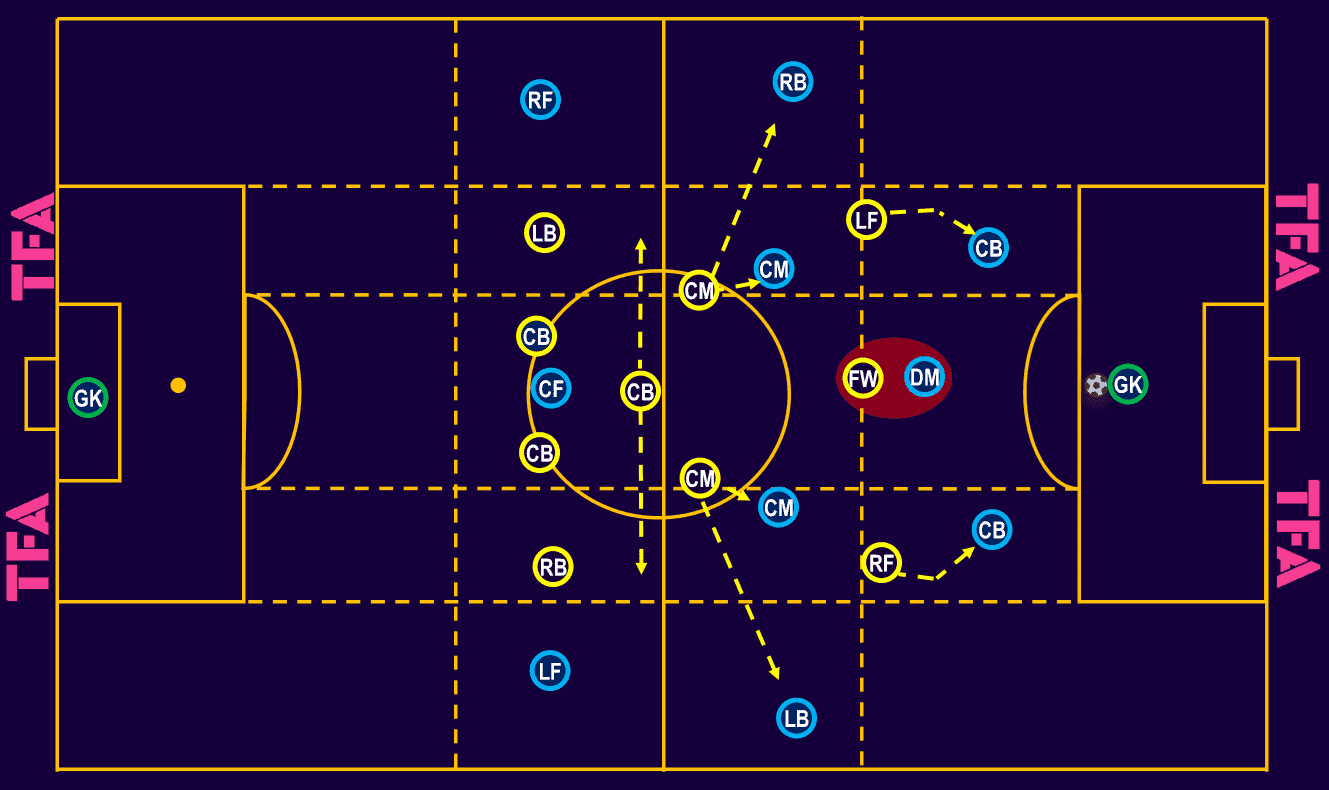
Colombia adapted slightly their in-possession 4-3-3 to become more of a 4-3-1-2 when out-of-possession.
The main difference from a traditional 4-3-3 structure was that the wingers played further inside the pitch, pressing the opposition’s centre-backs.
The highest two forwards tried to press the centre-backs whilst blocking passes into the full-backs.
The role of James Rodríguez was simple.
With the two forwards pressing ahead of him, he stayed between them to cover the ‘6’.
Behind the former Bayern Munich loanee, the three central midfielders positioned themselves narrowly, crowding the central areas.
When the opposition full-backs found the ball, the central midfielders pressed all the way in the wide area.
The central midfielders covering the wide areas meant Colombia’s full-backs rarely became stretched, allowing them to stay intact with their central defenders and cover the opposition’s wingers.
The aim of the press was to cut off any easy initial passes into the wide area and to force the opposition into a crowded central area.
The Role of James Rodríguez
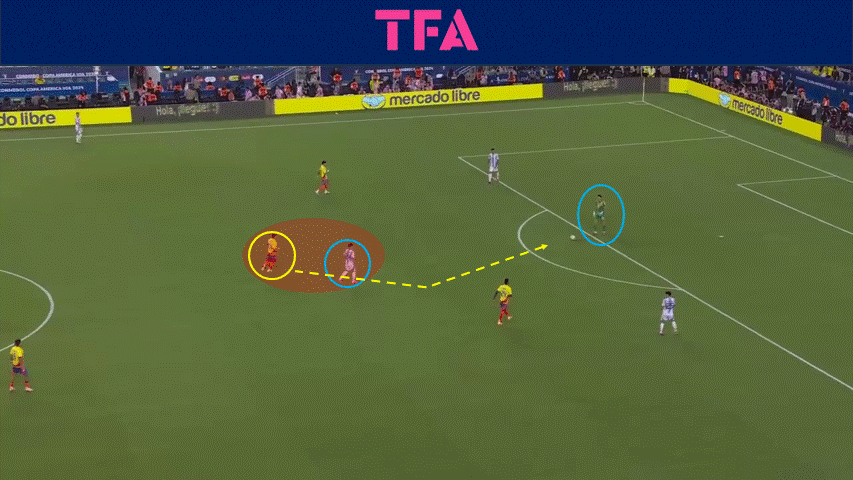
James’ main role was to prevent the opposition’s ‘6’ from receiving the ball in central areas.
The two wide forwards were positioned centrally whilst simultaneously cutting off ground passes to the full-backs and being close enough to press the centre-backs should they receive the ball.
In the scenario shown above, when James recognized the goalkeeper was stuck, the former Everton attacker pressed the goalkeeper whilst slightly arching his run to prevent the opposition’s ‘6’ from receiving the ball.
In this instance, the goalkeeper is prevented from playing centrally, and any clipped ball to his full-backs would be slow, meaning his full-backs would be under immediate pressure should they receive it.
This leaves playing long as the only option – exactly what Colombia want.
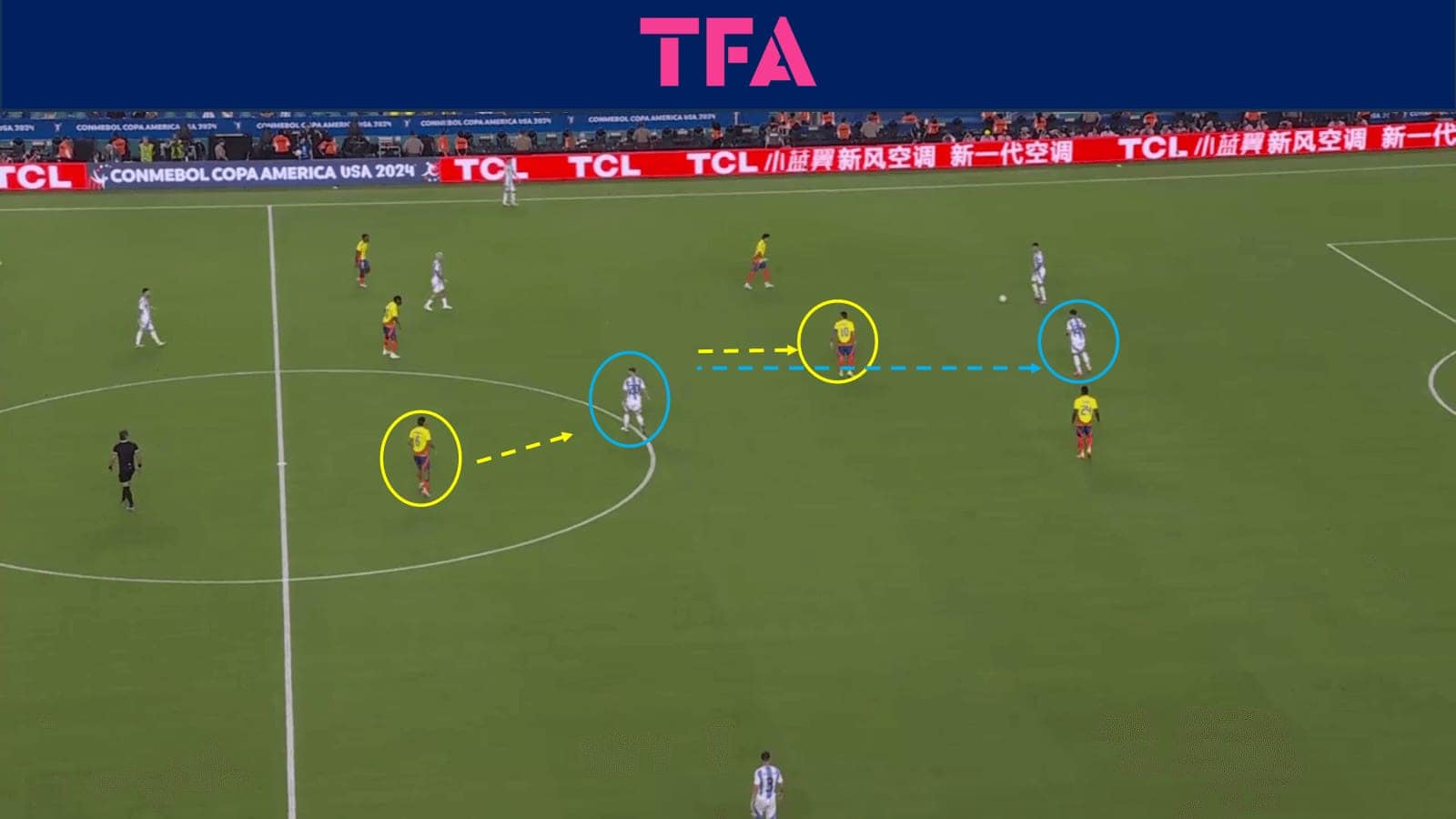
When the opposition’s ‘6’ drops deep, beyond Colombia’s front two, James lets the midfielder go and forms part of a flat front three.
This gives Colombia a midfield overload and prevents any easy progressive passes into the middle of the pitch.
Reacting To A Switch Of Play
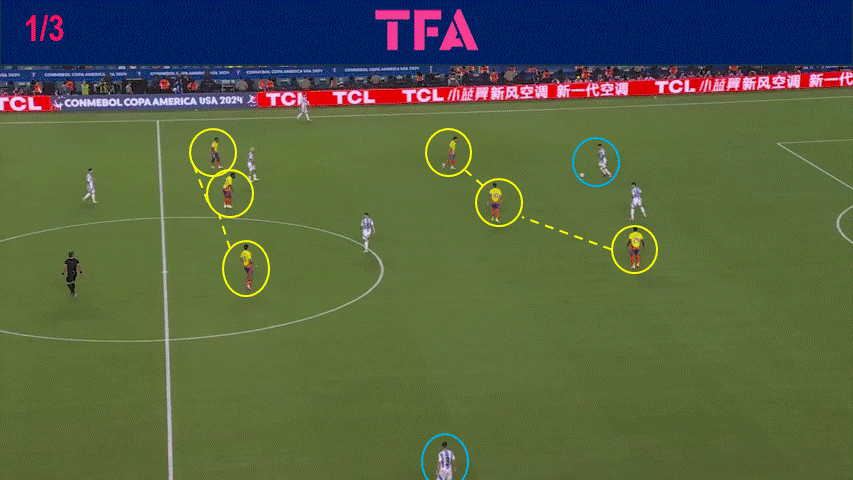
When the ball is allowed to be switched, usually over the press, to the opposition’s ball-far fullbacks is perhaps, as with many shapes, the most exposed and risky element of Colombia’s setup.
Colombia reacts to the ball-far full-back receiving by their nearest central midfielder sprinting to press the ball in the wide area, with his two midfield teammates shifting behind him.
This reaction has the benefit of allowing the back four to remain intact without their full-back having to jump to press.
However, it requires the midfield to cover a lot of ground, often as much as 40 meters, at high speeds.
By pressing the ball, as opposed to dropping off diagonally into a secure shape, Colombia force the opposition to play quickly.
This example forces the isolated Argentina left-back to attempt a risky pass into the middle of the pitch.
The speed at which the Colombian team add pressure to the ball and shift across allows them to pick up the ball in a very dangerous position, which they immediately take advantage of.
This form of pressure requires extreme athleticism, especially from the three midfield players, in terms of speed and endurance.
Trapping
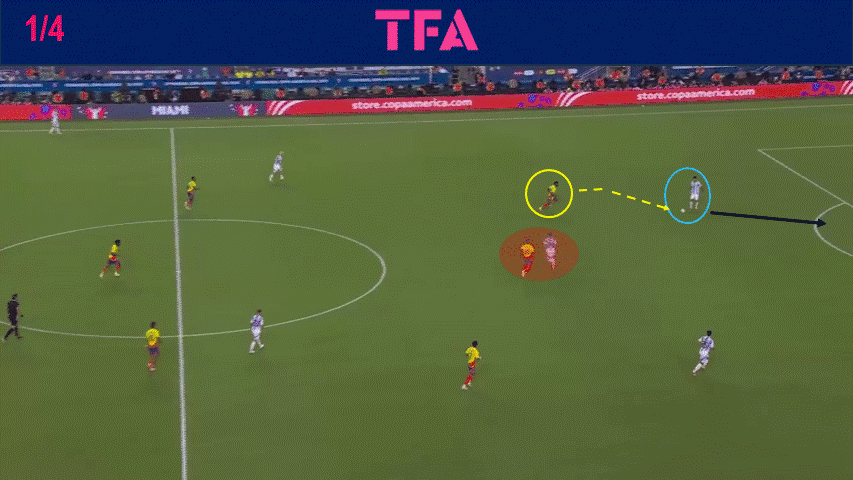
The main aim of Colombia’s setup was to crowd out the central areas where Argentina wanted to play and force them to either play a risky pass centrally or force Argentina back and trap them in the corners.
As shown above, when the forward initiated the press, he did so by looping his run slightly to cut off the full-back and force the centre-back inside.
By James occupying the opposition’s ‘6’, and the ball-far forward primed to press the opposite centre-back, this forced Argentina to go back to the goalkeeper to keep possession.
This backwards pass acted as a trigger for the whole team to initiate a full-on press.
The ball-near forward continued his pressing run to close down the goalkeeper while blocking a return pass to the centre-back.
James jumped ahead of his mark, and the ball-far forward began pressing the anticipated next pass.
The result, as shown above, was typically that all the near-passing options were cut off, and the defender was forced to clear the ball out of the pitch under pressure.
Argentina’s Solutions
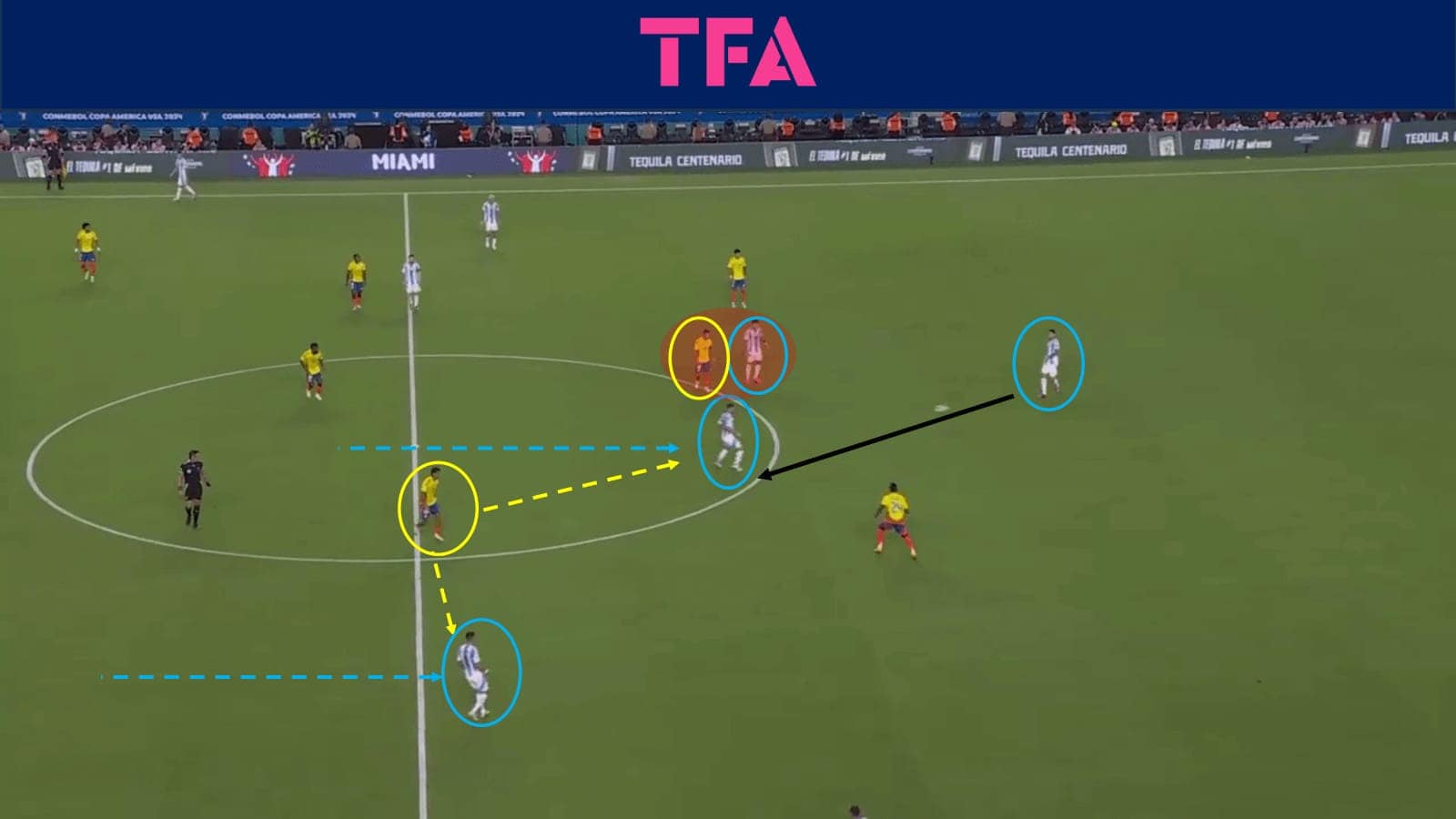
Argentina’s solution to the clear problems Colombia were causing them with their defensive structure came in two parts.
The first part was for one of the ‘8’s’ to drop towards the ball, creating a double pivot.
With James staying tight to the ‘6’ and the nearest midfielder remaining static to both protect the space behind him and cover with Di Maria, who had also dropped down, the ‘8’ was allowed to receive alone.
Had Colombia’s right-forward narrowed even more to shield the double-pivot, Argentina would have been able to easily escape down their left side.
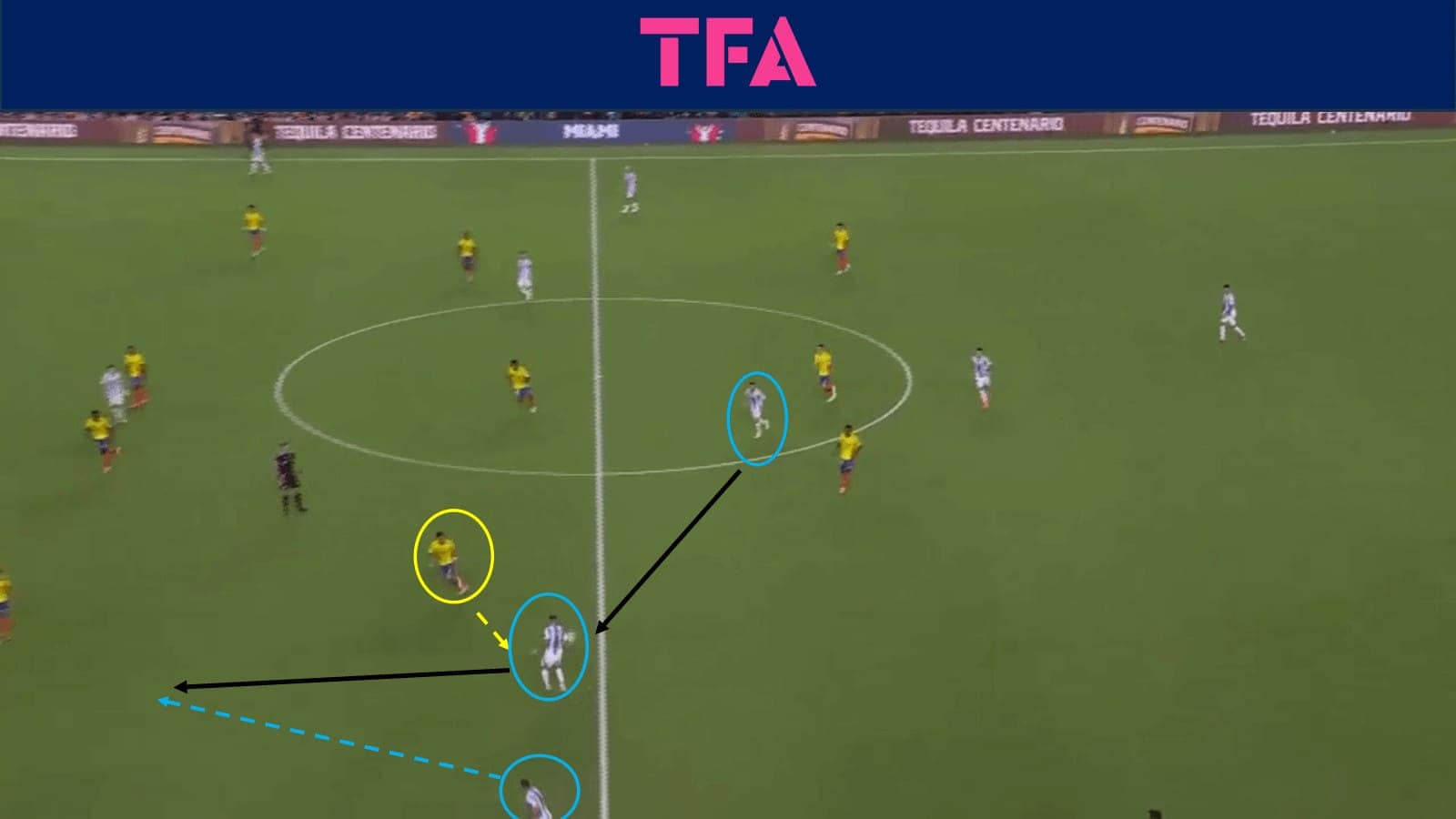
The second part of Argentina’s solution was for Di Maria (circled, on the ball) to drop deep in the half-space.
The positioning of the former Manchester United winger meant that when he received, the widest Colombian midfielder jumped to him rather than shifting all the way across to the full-back in the wide area.
This allowed the left-back to receive alone deep into Colombia’s half.
6 Vs 6 + 6 Rondo
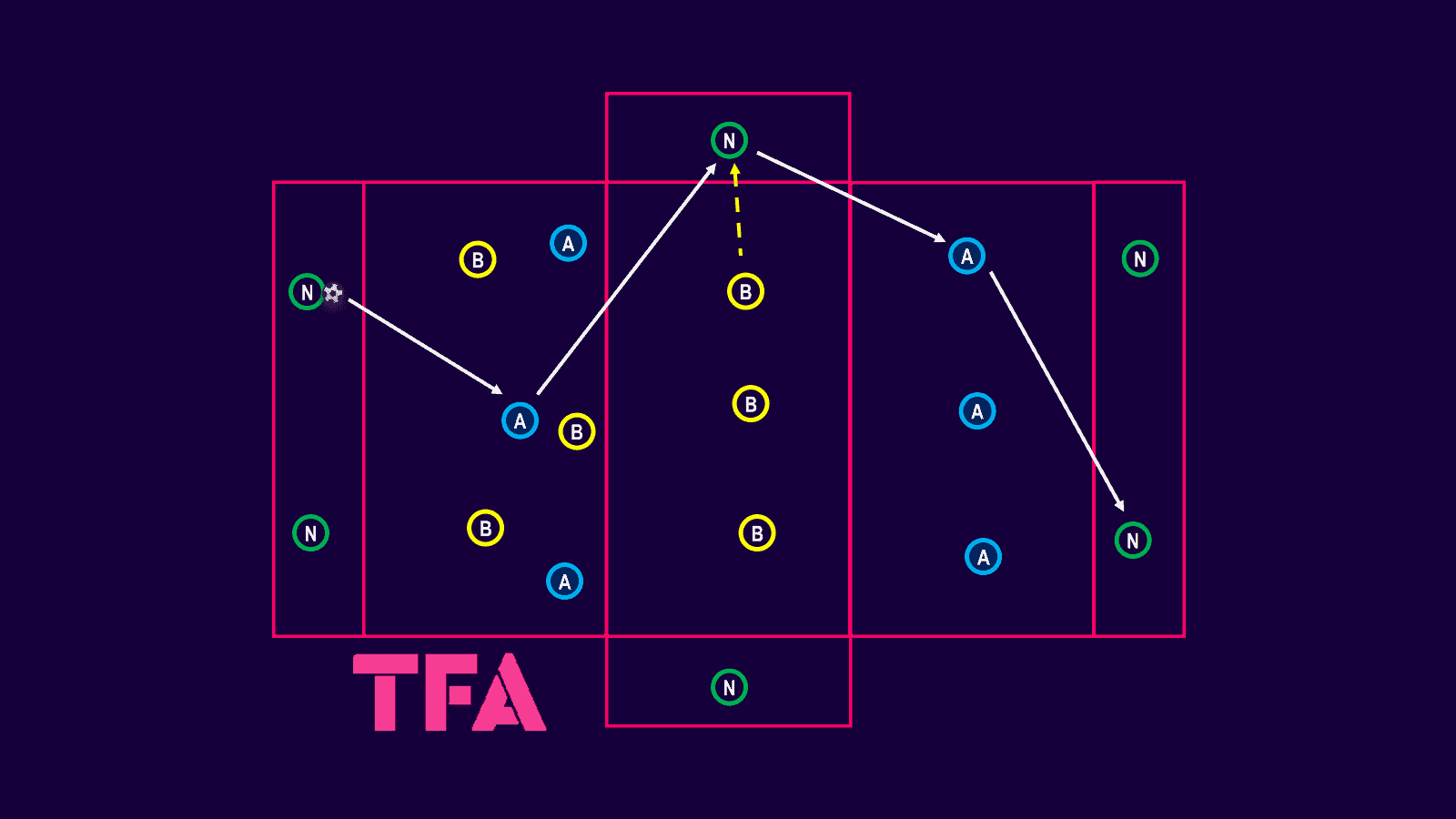
A vital component of the 4-3-2-1 press implemented by Colombia is the ability, both physically and tactically, of the midfield three to cover the width of the pitch.
This rondo allows coaches to work on the side midfielders pressing in the wide area, with the two ball-far midfielders shifting and dropping off behind.
The principles of this can be embedded in a much smaller, condensed area so as to save the player’s energy or implemented on a full-size scale.
Coaches working with younger age groups may also want to utilize a smaller area.
The players are divided into three teams of six.
A neutral team that plays for whichever team has possession is positioned in two boxes at either end of the exercise and two boxes at the side.
The side players represent full-backs, and the end players represent centre-backs in the build-up phase.
The attacking team is split into three and three, separated by the middle box, and must remain in these areas.
The defending team has three players, mimicking two forwards and an attacking midfielder in the end box with the ball and three players, playing as a midfield unit in the central zone.
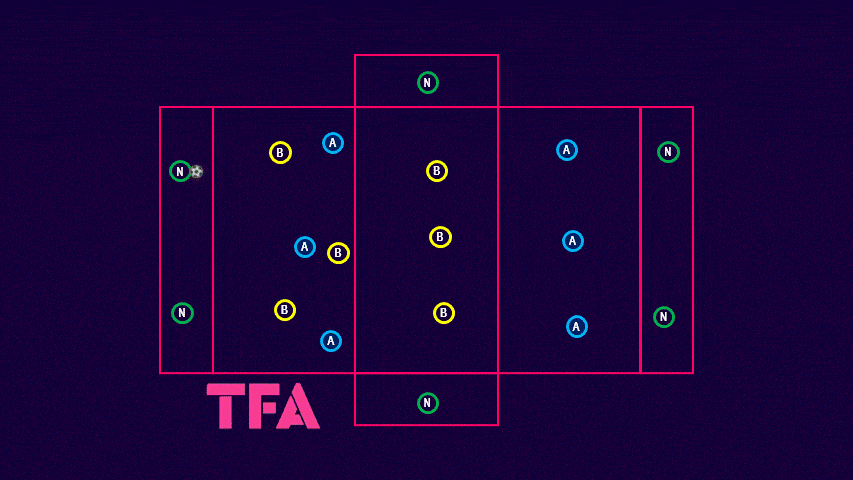
The play begins with the end neutral players and attacking players aiming to work the ball to the side players, who then switch the ball into the opposite box.
Once this is achieved, the midfield become the pressing players with their three teammates transitioning into the middle zone.
If the defending team gains possession, they should attempt to pass to a neutral player before taking up the attacking positions in the two end boxes.
Initially, the neutral players are in a safe zone so cannot be dispossessed, only their passes can be intercepted.
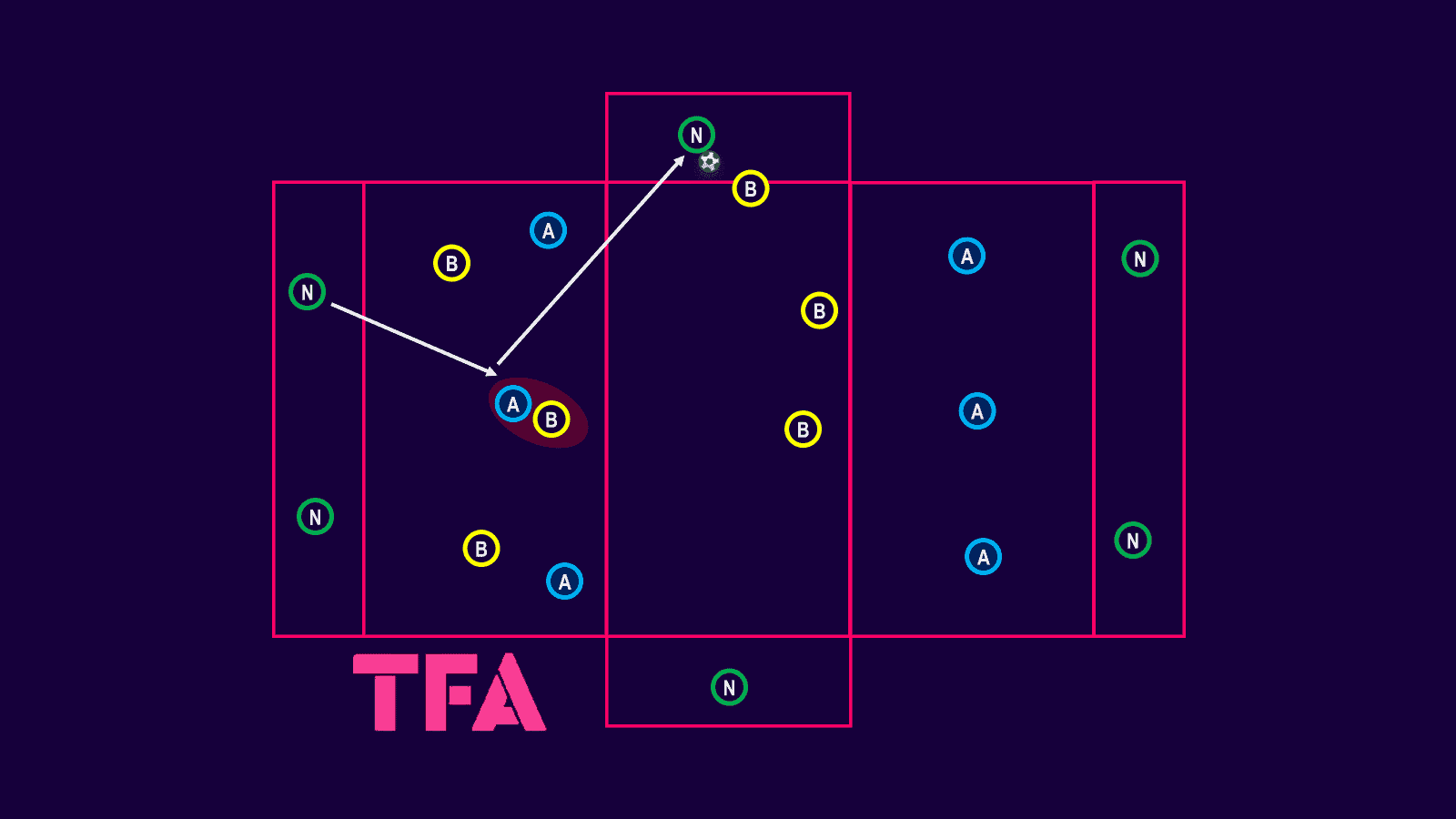
The above image shows the positioning the midfielders should take up to prevent a forward pass when the full-back receives the ball.
Anticipation, followed by an immediate reaction to press is required by the ball-near midfielder with the far two shifting across and dropping behind their teammate.
With the end neutral players being allowed to pass directly into the side neutral players, the forwards are forced to position themselves between the opposition centre-backs and full-backs.
The attacking midfielder should reference the most central player and not allow that player to easily get on the ball.
By having three players in this zone, the attacking team replicates the opposition, as in Argentina’s case, creating overloads lower in the pitch and making things as difficult as possible for the front three to defend.
To progress the exercise, when the defending team begins to jump too early in anticipation of the wide pass, the rules can be adapted to allow the in-possession team to play through them centrally – exactly what Argentina desired to do against Colombia.
The team in possession should be coached in movements that allow them to effectively find their wide player and switch the ball to the opposite box.
By doing this, coaches prepare their team to face scenarios that test the weakest aspects of their defensive structure.
To that point, the coaching points of this rondo can also be flipped to work on breaking down such a defensive block.
Passing Sequence – Breaking Down A 4-3-2-1

This passing sequence could be used to embed certain principles that would aid in breaking down a similar 4-3-1-2 pressing structure to Colombias.
The key aim is to attract Colombia centrally before quickly playing out wide and penetrating through their midfield.
The sequence begins with player “A”, representing a centre-back, passing into player “B”, a midfielder, who bounces the ball back to the starting player at an angle as if they have played around the pressing forward.
The midfielder moves away from the ball before moving towards the straight pass at an angle that allows the ball to be played with their backfoot, the way they are facing.
The ball is then played first time into ‘C’, the full-back, who has dropped to receive the ball.
By dropping to a low position to receive, the full-back makes themselves more difficult to press and creates more space behind themself, higher up the pitch.
The full-back completes another bounce pass to the centre-back, who then exploits the space created behind by playing a through ball for the full-back to spin and run onto.
‘C’ takes a touch before passing to ‘D’, who then begins a new sequence, repeating the same pattern on the opposite side.
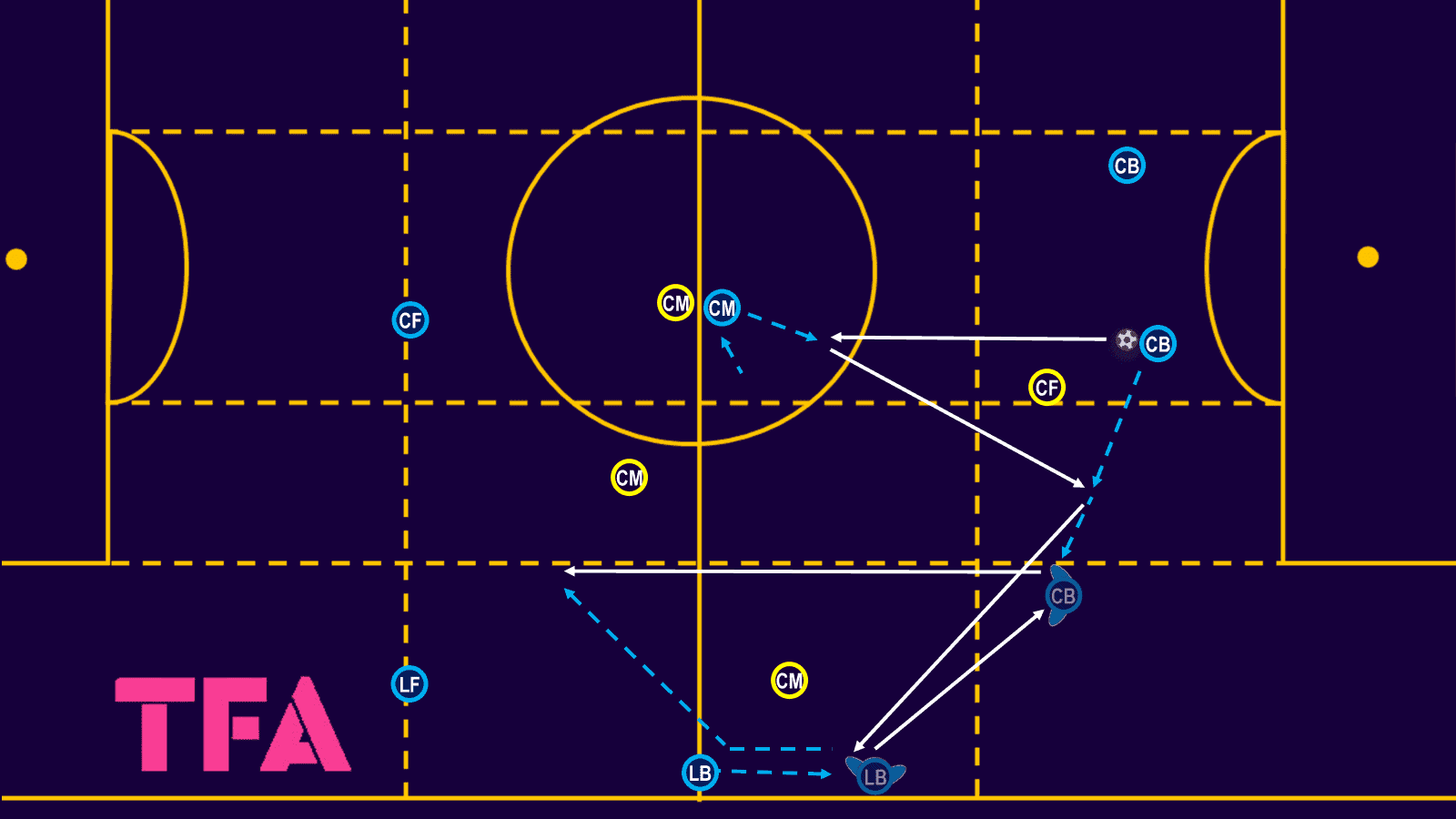
The above image shows the attacking players involved in the passing sequence, plus four of the key opposition players.
The initial forward pass into the central midfielder is designed to narrow the opposition’s midfield, which makes it more difficult for them to press the outside pass effectively as they are positioned too centrally.
The image also depicts how the centre-back should move to circumvent the pressing forward, playing a pass on one side before moving to the forward’s blindside for the next ball.
Conclusion
Colombia’s pressing setup was integral to their success at this year’s 2024 Copa América.
Whilst Argentina came up with solutions, they suffered a lot in trying to play out cleanly and rarely got their most dangerous players on the ball in central areas.
Argentina also gave up several dangerous chances on the back of how Colombia pressed.
This tactical analysis offers suggestions on how to both implement this form of pressing and how to effectively play against it.






Comments